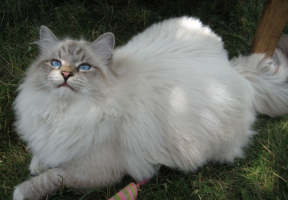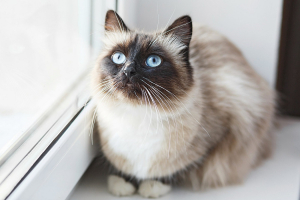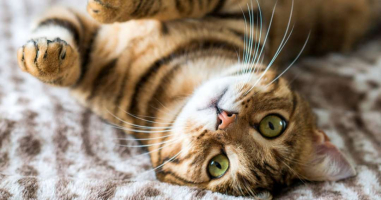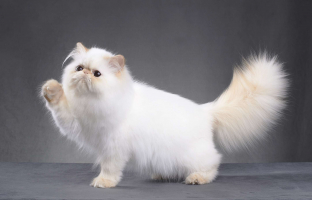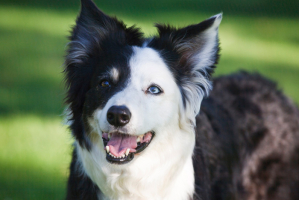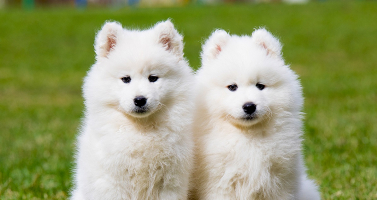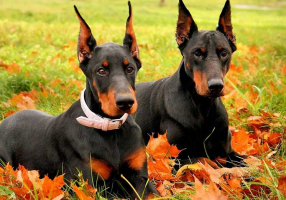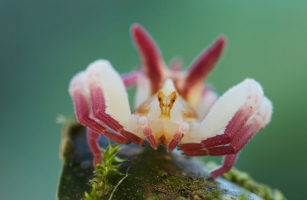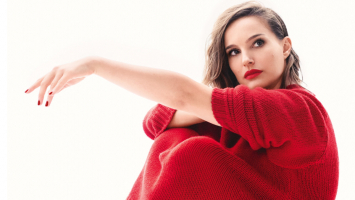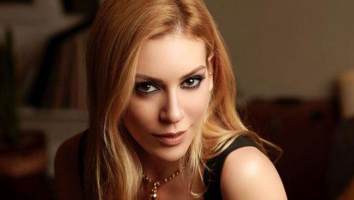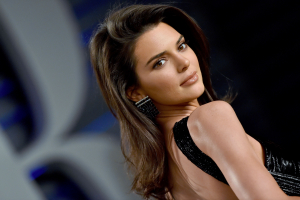Top 16 Most Beautiful Shorthair Cat Breeds
All cats are gorgeous in their own way, and many breeds have additional enticing qualities besides beauty, such as temperament, playfulness, and intellect. ... read more...That being said, there are some incredibly stunning breeds out there, and this essay is dedicated to them! Each of these breeds has distinct characteristics that distinguish them as attractive and enjoyable to possess. Let's discover the most beautiful shorthair cat breeds now.
-
The American Curl is a cat breed distinguished by distinctive ears that curl back from the face toward the middle of the rear of the skull. A natural mutation gave rise to the breed in Lakewood, California. American Curl kittens are born with straight ears that begin to curl within 48 hours. After four months, their ears should be firm and rigid to the touch at the base of the ear, with flexible tips, rather than curling. Although a pet-quality American Curl may have nearly straight ears, showcats must have ears that curl in an arc between 90 and 180 degrees.
Although a 90-degree angle is preferred, cats will be disqualified if their ears contact the back of their skulls. American Curls, both longhaired and shorthaired, have smooth, silky coats that lie flat against their bodies. They are low-maintenance and like spending time with their owners. While the American Curl is still a rare breed, it may be found in the United States, Spain, France, Japan, Russia, and many other nations. The American Curl is a relatively healthy breed due to its huge genetic pool of non-pedigree cats. Their ears, however, should be treated with care since harsh handling can damage the cartilage in the ear and need frequent cleaning to prevent infections. Several matings between cats with curled ears and cats without curled ears demonstrated that the curl gene was inherited dominantly.
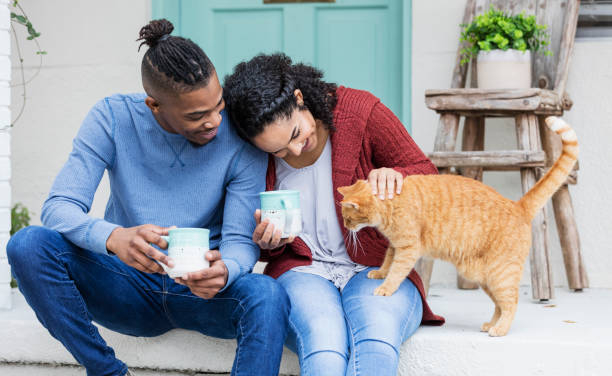
istockphoto 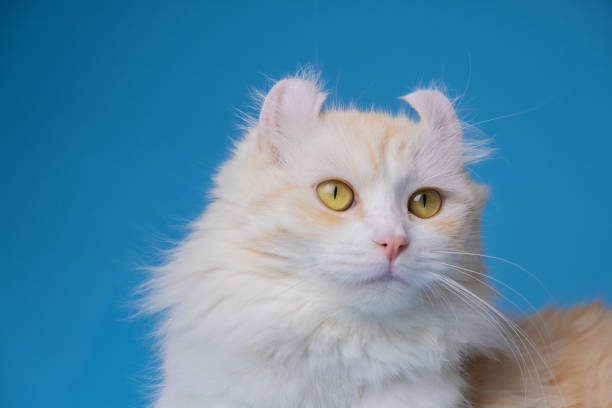
istockphoto -
The Bombay cat is a short-haired cat that was created by mating sable Burmese and black American Shorthair cats to generate a cat that is primarily Burmese in appearance but with a sleek, panther-like black coat. Bombay is the Asian group's work for black cats. Nikki Horner, a breeder from Louisville, Kentucky, began attempting to create a breed of cat that resembled a small black panther in 1958. The first effort failed, but the second attempt, in 1965, was successful. The Cat Fanciers' Association formally recognized and registered the breed in 1970, followed by The International Cat Association in 1979.
The Bombay is a domestic cat with short fur that is related to the Burmese. Bombay cats are distinguished by their all-black coat, black soles, black nose and lips, and copper or green eyes. The black coat is close-lying, silky, and glossy, and is normally pigmented to the roots with little or no paling. The Bombay has a strong medium body build. Their weight ranges from 8 to 15 pounds (3.6 to 6.8 kg), with males being bigger than females. A healthy Bombay may expect to live for 15 to 20 years. They may experience nasal issues, sneezing, and gingivitis. To avoid overfeeding, their food consumption should be restricted.
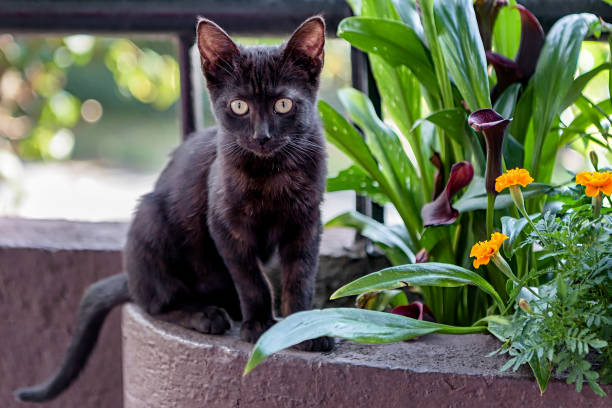
istockphoto 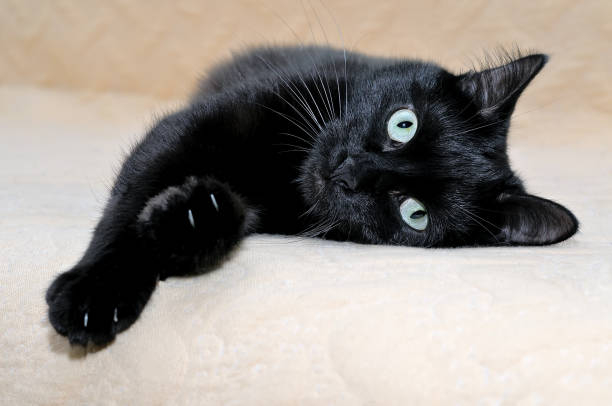
istockphoto -
The pedigreed variant of the classic British domestic cat, with a characteristically stocky build, thick coat, and large face, is the British Shorthair. The "British Blue" color variety is the most well-known, with a solid grey-blue coat, orange eyes, and a medium-sized tail. The breed has also been bred in a variety of various colors and patterns, such as tabby and colorpoint. It is one of the oldest known cat breeds. According to the UK's Governing Council of the Cat Fancy (GCCF), it is still the most popular pedigreed breed in its own nation today. British Shorthairs account for one-quarter of all kittens registered with the GCCF each year, making them the most popular pedigree cat in the UK.
The British Shorthair is a huge cat with a wide chest, strong thick-set legs with rounded paws, and a medium-length, blunt-tipped tail. The head is quite wide and rounded, with a short nose, broad cheeks (particularly visible in adult males, who acquire pronounced jowls), and large round eyes that are rich coppery orange in the British Blue and vary in color depending on coat. Their huge ears are broad and spread apart. The grey Scottish Fold, a breed related to the British Shorthair, is sometimes mistaken with the British Blue variation. The Shorthair, on the other hand, is distinguished by its pointed triangular ears, whilst the Fold has softer, folded ears.
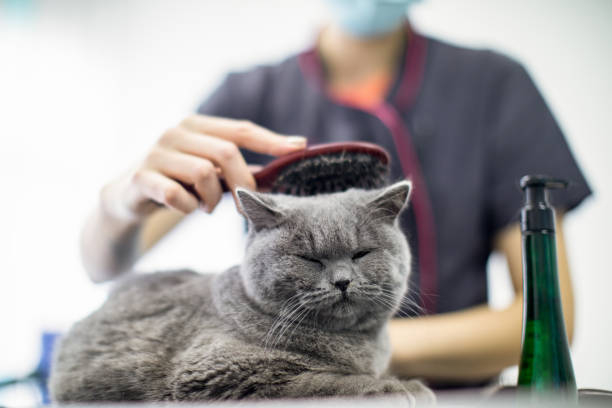
istockphoto 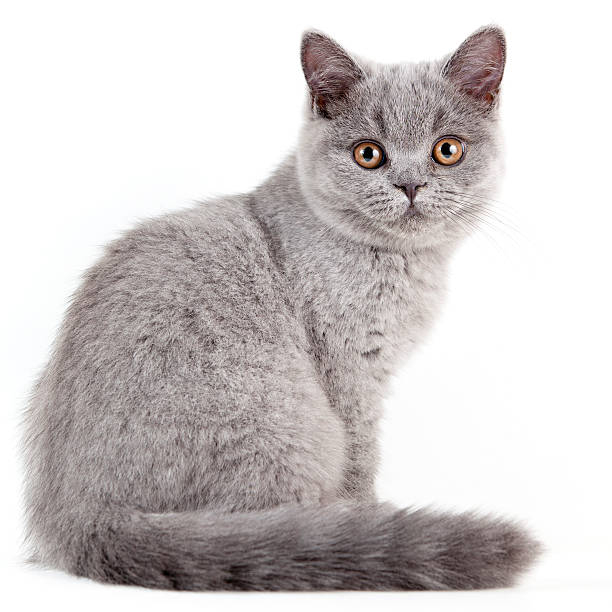
istockphoto -
The Cornish Rex is a domestic cat breed. Except for down, the Cornish Rex has no hair. Most cat breeds have three types of hair in their coats: guard hairs on the outside, awn hair in the center, and down hair or undercoat, which is very fine and roughly 1 cm long. Cornish Rexes have only the undercoat. They are prone to hair loss, with many developing a very thin coat or even becoming bald over substantial areas of their bodies. Their fur curls due to a different mutation and gene than that of the Devon Rex. The breed originates in Cornwall, England.
Cornish Rex coats are incredibly delicate and occasionally frizzy. Because of their light coat, they are best suited for indoor dwelling in warm and dry environments, as they are sensitive to low temperatures. They prefer to be near warm objects like computer displays, light bulbs, laps, and shoulders. Because of the type's sleek look and galloping pace, the breed is frequently referred to as the Greyhound of cats. These cats are known to remain energetic and kittenish throughout their lives. Some Cornish Rexes like playing fetch, racing other pets, and performing acrobatic leaps. The Cornish Rex is an adventurous and clever cat. It is adaptable to new settings and will move anywhere it can. The Rex is exceedingly curious, enjoys human interaction, and is sociable to other companion animals.
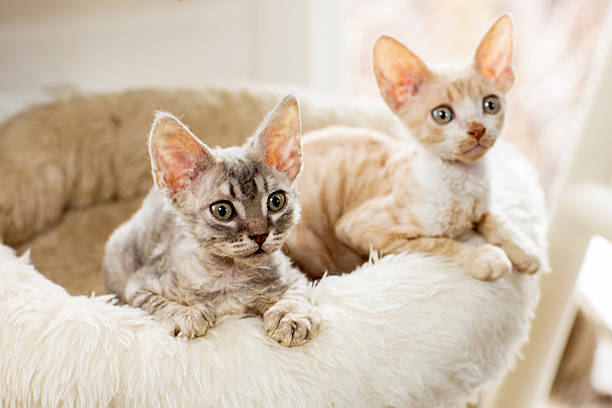
istockphoto 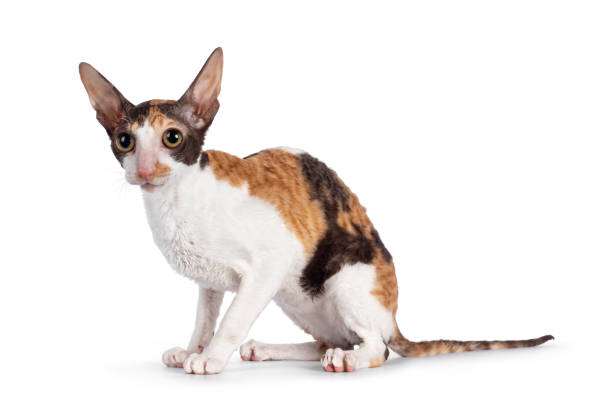
istockphoto -
Egyptian Maus are a tiny to medium-sized breed of short-haired cat. They are one of the few naturally marked domesticated cat breeds. The Mau's markings appear solely on the tips of its coat's hairs. It is regarded as an uncommon breed. Proponents consider Egyptian Maus to be one of the progenitor breeds of the current domestic cat. The breed's conformation is characterized as follows: "a cross between the compactness of a Burmese and the thin grace of a Siamese. Its powerful medium-length physique, with rear legs longer than front, gives the Mau the illusion of standing on tiptoes when erect".
The Egyptian Mau is the quickest of the domestic cats, thanks to its larger hind legs and a distinctive skin flap stretching from the flank to the back knee, which aids in running by allowing the legs to stretch back farther, allowing for more agility and stride length. Maus have been clocked at speeds exceeding 48 km/h (30 mph). This breed's main distinguishing feature is a long, black dorsal stripe that extends from its head to its tail down its spine. Maus are available in six different colors. Silver, bronze, smoke, black, caramel, and blue/pewter are the most prevalent colors.
Pewter and black Maus cannot be displayed, but they may be bred. All Maus must have green eyes, however kittens and young adults up to eighteen months old can have an amber cast. The Mau is well-known for having a devoted, lively, and sociable attitude. Maus are more climate sensitive than other breeds, preferring extremely hot conditions.
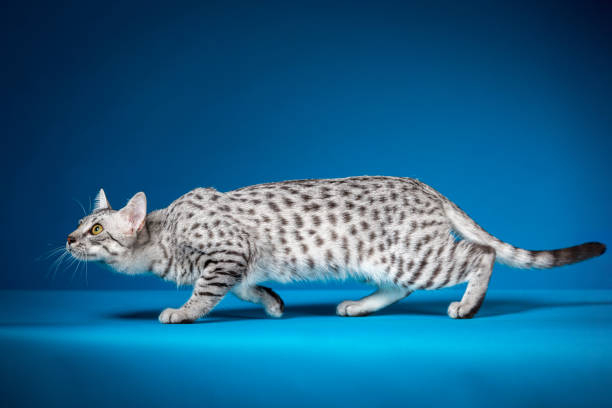
istockphoto 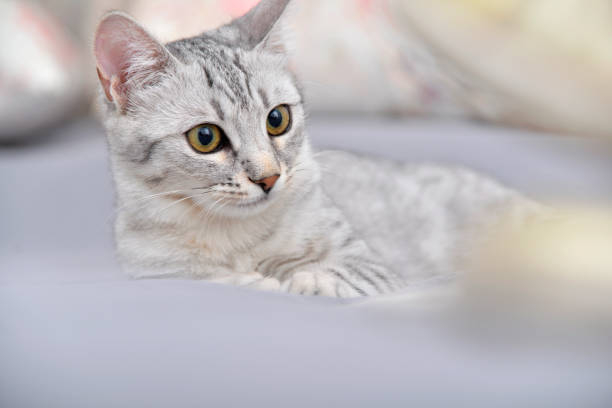
istockphoto -
In the 1950s, a group of cat fanciers in England arranged a mating between Siamese and domestic black cats, which resulted in the Havana Brown. Early breeders included a Siamese-type Russian Blue in their crosses. However, recent genetic research indicates that nearly none of them remain in the gene pool. Self-brown cats were presented in Europe in the 1890s, and one name given to these was the Swiss Mountain Cat. These vanished until after WWII, with the most likely cause being that the Siamese Cat Club of Britain forbade breeding. The Swiss Mountain Cat was never employed in current Havana Brown breeding efforts. They do, however, share DNA acquired from the Siamese.
The Havana Brown is a well-balanced, medium-sized, muscular short-haired cat with an average body length. Sterilized animals tend to grow bigger and more fat. In comparison to other short-hair cat breeds, they are a reasonably active breed. The coat must be a warm brown, often reddish-brown, with no visible tabby markings (note that kittens will always show markings, but they resolve as the cat ages and dissolve completely by one year). The whiskers must likewise be brown, and the eyes must be green. The head should be somewhat longer than broad, but never seem wedge-shaped. In profile, the nose/muzzle should come to a halt and shift direction at the eyes.
Paw pads must be pink or rose in hue and never black. Ears are typically medium in size. A Havana Brown should be beautiful and reasonable, with no excessive traits. Males are bigger than females and have an average weight when compared to other breeds.
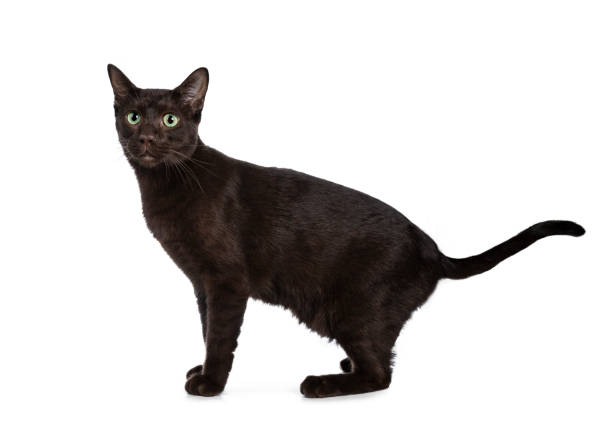
istockphoto 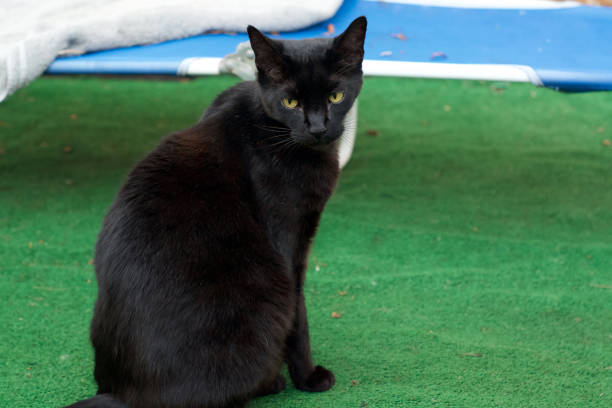
istockphoto -
The Abyssinian is a domestic short-haired cat breed that has a characteristic "ticked" tabby coat with individual hairs banded with various colors. They are sometimes referred to as Abys. The name is derived not from Ethiopia, previously Abyssinia, which is regarded to be the native habitat of these cats, but from the fact that the first "Abyssinians" shown in exhibits in England were said to have been brought from there. According to genetic analyses, its original origins are thought to have been along the Indian Ocean's coast in regions of Southeast Asia, and it was introduced to Abyssinia (and others) by colonialists and merchants passing via Calcutta.
The breed's unusual look, which seems long, thin, and beautifully colored in comparison to other cats, has been compared to that of human fashion models. The cats' personalities are often lively and interested, and they regularly follow their owners around and encourage play. Their dog-like features include a strong feeling of love and a strong need for interaction. With its ticking coat and huge upright ears, abys have a characteristic wildcat appearance. They are a very gregarious breed that may be somewhat demanding of attention. Because of their gregarious nature, they fare well in multi-cat families. Abyssinians are not lap cats; they are always on the move, either exploring or playing.
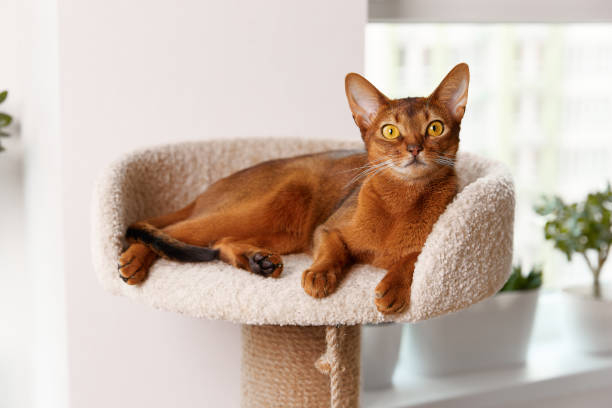
istockphoto 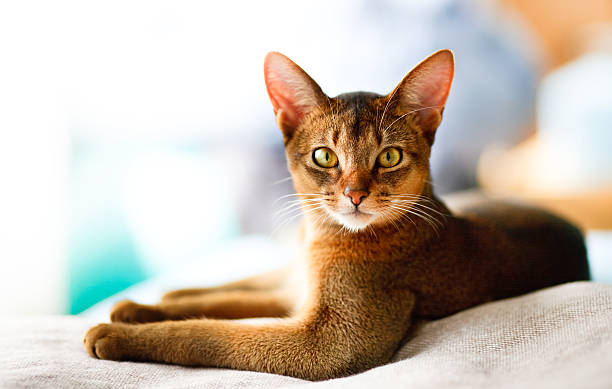
istockphoto -
The Korat cat is a short-haired, silver-tipped blue-grey domestic cat with a petite to medium physique and a low proportion of body fat. It has a semi-cobby body that is exceptionally hefty for its size. It is a clever and fun energetic cat that creates deep ties with humans and is quite talkative, with a unique voice compared to other breeds. The Korat's heart-shaped skull and huge emerald eyes are among its defining features. It has shorter front paws than back paws.
The Korat is a natural breed and one of the oldest stable cat breeds, as well as one of the few that has not altered look over time. It originated in Phimai, Thailand, and is named after the province where it originated, Nakhon Ratchasima Province (typically called "Korat" by the Thai people). In Thailand, the breed is known as Si sawat, meaning "colour of the sawat seed". The Korat is also known as the "lucky cat" in popular parlance. They are traditionally given in pairs to newlyweds or highly valued persons for good luck. Korats were never sold and were solely given as gifts until recently.
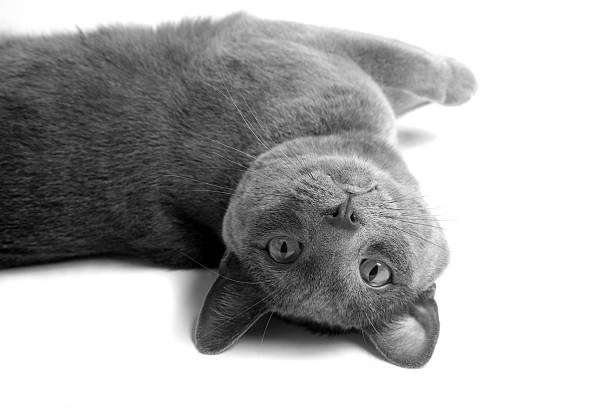
istockphoto 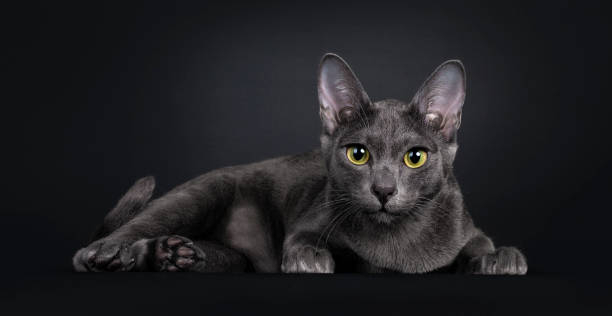
istockphoto -
The Manx cat is a domestic cat (Felis catus) breed that originated on the Isle of Man and has a naturally occurring mutation that shortens the tail. Many Manx cats have a stub of a tail, but Manx cats are most recognized for being fully tailless; this is the breed's greatest defining feature, along with lengthened hind legs and a rounded skull. Manx cats occur in a variety of coat colors and patterns, while all-white individuals are uncommon, and the original stock's coat range was more limited. Long-haired varieties, known as Cymrics, are sometimes regarded a different breed.
Manx are recognized as expert hunters, and as such, they are frequently sought after by farmers with rodent issues, as well as being a favoured ship's cat breed. They are described as gregarious, gentle, and energetic. Stubbin or rumpy is an old local word for the cats on their native island. Since the 1800s, Manx cats have been shown at cat exhibitions, with the first documented breed standard issued in 1903. Although tail suppression is not the only distinguishing trait of the breed, the absence of a tail to having a tail of any length between the two extremes is the main identifying feature of the Manx cat. This is a naturally occurring cat body-type spine mutation generated by a dominant gene.
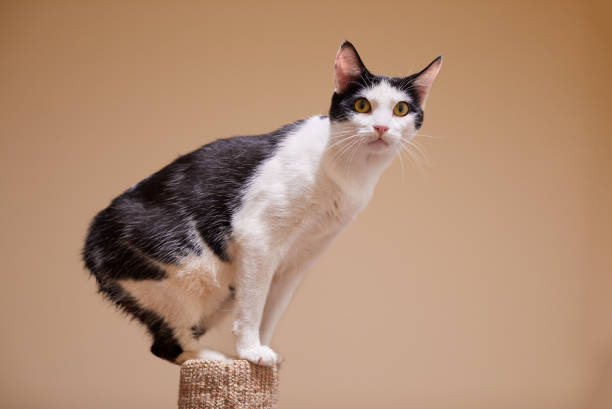
istockphoto 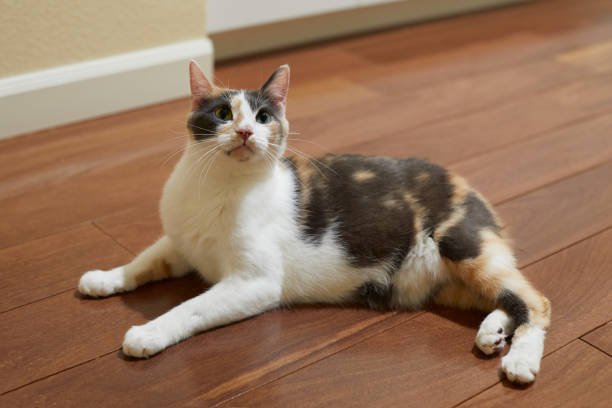
istockphoto -
The Oriental Shorthair is a domestic cat breed that descended from and is closely related to the Siamese cat. It has the current Siamese head and body form but comes in a variety of coat colors and patterns. Orientals have almond-shaped eyes, a triangular head shape, huge ears, and an extended, slender, and muscular frame, similar to Siamese. They also have extremely similar personalities. Orientals are gregarious, intellectual, and often rather outspoken. They frequently stay lively throughout age, with many loving fetches. Despite their thin look, they are active and can leap to great heights. They like to live in groups or couples and want human connection. Orientals, unlike their blue-eyed forefather, are frequently green-eyed.
The Oriental Longhair differs only in length of coat. The Oriental Shorthair belongs to the Siamese breed family and comes in a variety of solid colors and patterns, including smoky, shaded, parti-color/tortoiseshell, tabby, and bicolor (any of the above, with white). Some varieties are not accepted by all organizations that recognize the breed. Oriental Shorthair cats have a high degree of mobility and are natural talkers. Breeders and vets believe mature Oriental Shorthair cats to be lively, curious, and interested in their environment.
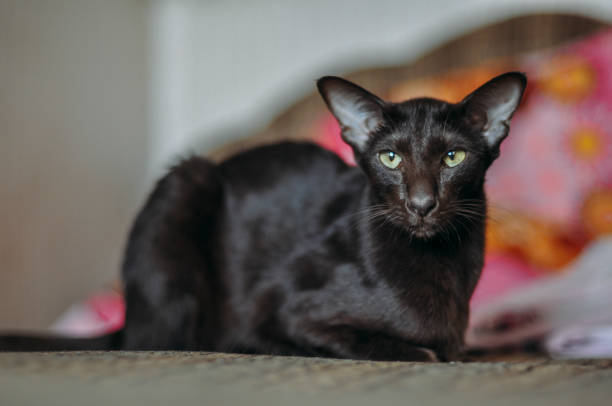
istockphoto 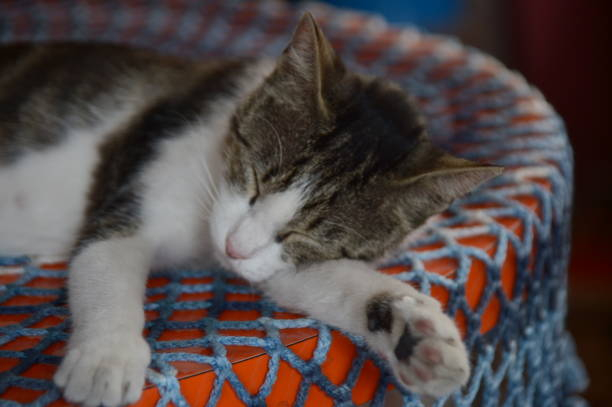
istockphoto -
The Pixie-bob is a domestic cat breed that is said to be the offspring of naturally occurring bobcat hybrids. However, DNA testing has failed to discover bobcat marker genes, thus Pixie-bobs are regarded as entirely domestic for reasons of ownership, cat fancy registration, and import and export. They were, however, chosen and developed to resemble American bobcats. Pixie-bobs are a totally domestic breed of cat that has been chosen and developed to look like a North American bobcat. Pixie-bobs can be huge, but on average they weigh approximately 5 kg, which is comparable to a good-sized domestic cat, with just a few breeders regularly producing large cats. They are often big-boned, muscular, and bulky. Males are often bigger than females. A pet cat weighs roughly 4 kilograms on average.
The majority of Pixie-bobs have black fur and skin on the bottoms of their paws, pointed ears, thick ear hair, black lips, and white fur around the eyes with black eye skin. They have a big snout with circular whisker pads and a crimson nose leather. Their chins have white fur; however, they frequently have black flesh behind the white hair.
Some of their whiskers become white as they age. Their bobcat-like hair pattern sometimes includes reddish tones. The majority have short hair, while some have long hair. The brow should be thick, and the eyes should be trapezoidal. When kittens are young, their eyes are blue, but after a few months, they become green or gold. Tail length can range from 2 inches (5 cm) to hock length when leg is extended. The head is pear-shaped and is considered the most essential feature.
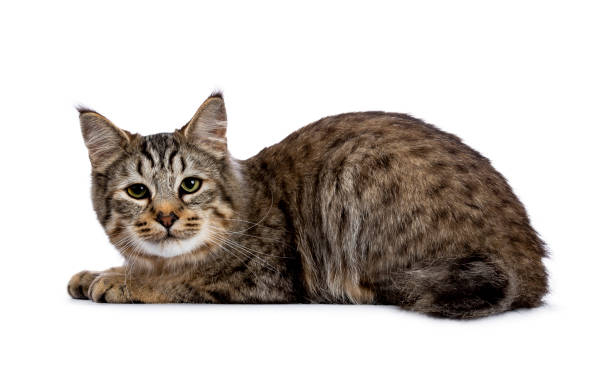
istockphoto 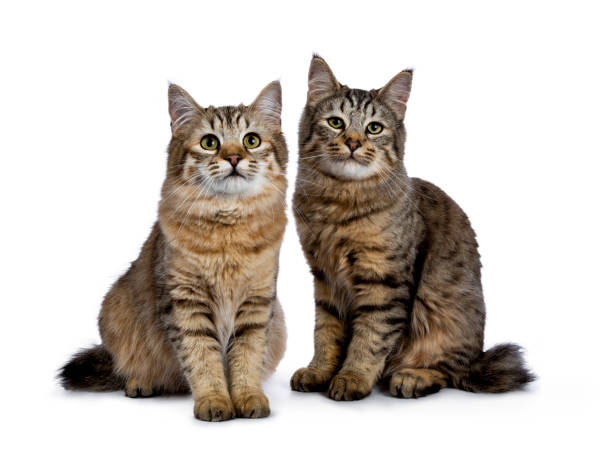
istockphoto -
The Russian Blue Cat, sometimes known simply as Russian Blue, is a cat breed whose hues range from a bright shimmering silver to a deeper slate grey. For more than a century, the breed's distinguishing feature has been its short, thick coat that sticks out from the body. The Russian Blue has vivid green eyes, pinkish lavender or mauve paws, and a blue-grey-black coat. The hue is a bluish-gray result of the black gene's diluted expression.
The coat is a "double coat", with the undercoat silky, downy, and equal in length to the guard hairs, which are a uniform blue with silver points. The tail, on the other hand, may have a few extremely dull, nearly undetectable stripes. Thick, fluffy, and pleasant to the touch, the coat is characterized. The silver accents on the coat make it glitter. Its eyes are usually always a deep, vibrant green. In show cats, any white patches of fur or yellow eyes in adulthood are considered defects. Russian Blues should not be confused with British Blues (which are not a distinct breed, but rather a British Shorthair with a blue coat because the British Shorthair breed itself comes in a variety of colors and patterns), nor with the Chartreux or Korat, two others naturally occurring breeds of blue cats with similar characteristics.
The Russian Blue is an inquisitive and peaceful creature. They are recognized for their warmth, intellect, and quiet demeanor. They have been observed playing fetch and opening doors, as well as being sensitive to human emotions. They like playing with various toys and form strong ties with their loved ones and other family pets. They are a calm breed in general, but there are always outliers.
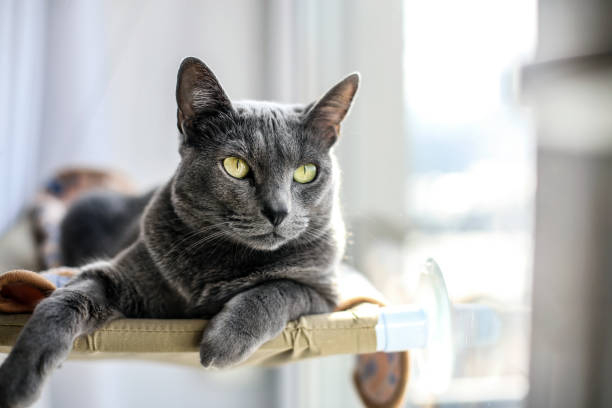
istockphoto 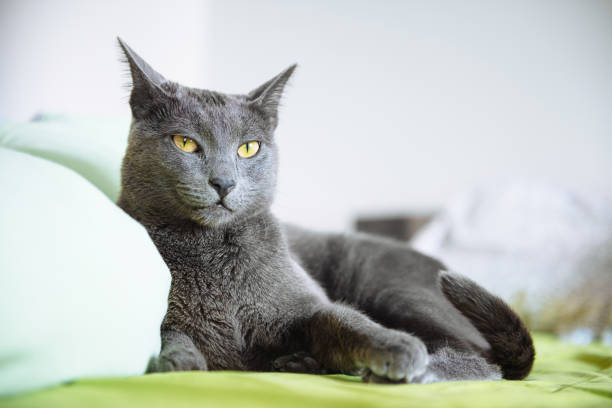
istockphoto -
The Scottish Fold is a domestic cat breed that has a natural dominant gene mutation that affects cartilage throughout the body, causing the ears to "fold," folding forward and down towards the front of the head, giving the cat an "owl-like" look. Scottish Straights are Scottish Fold kittens who do not acquire folded ears. Originally, cats had just one-fold in their ears, but through selective breeding, breeders have enlarged the fold to a double or triple fold, causing the ear to rest completely flat on the skull.
The Scottish Fold is a medium to large-sized cat that can be any color, including calico. Males weigh 4-6 kg, while females weigh 2.7-4 kg. The Fold's entire body shape is rounded, especially the head and face, and the eyes are huge and spherical. The cat's nose is small and gently curved, and its body is well-rounded with a padded appearance and medium-to-short legs. The top of the skull is domed, and the neck is relatively short. The Scottish Fold has a "sweet look" thanks to its widely separated eyes. Scottish Folds can have long or short hair, and almost any coat color or mix of colors (including white). Shorthair Scottish Folds have thick, velvety fur, but longhair Scottish Folds have longer, more dense fur on their upper thighs, toes, ears, and tail.
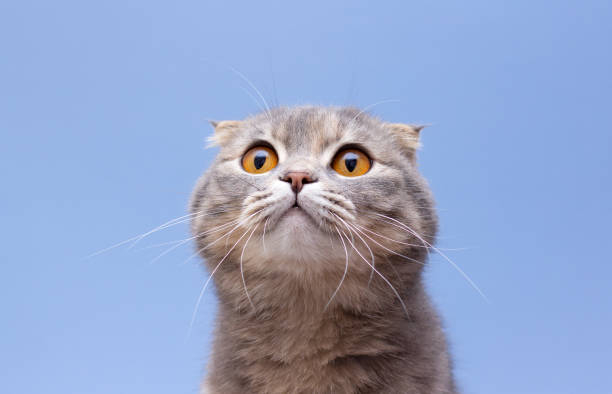
istockphoto 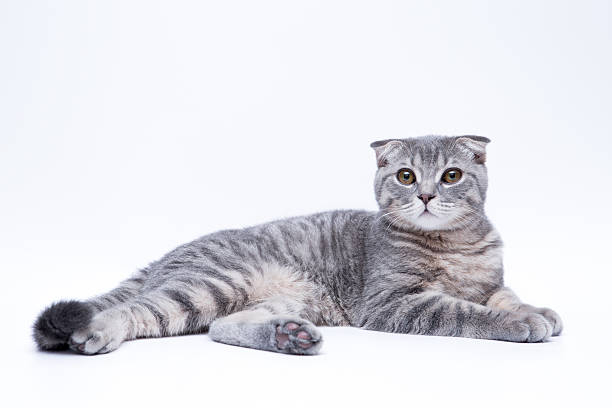
istockphoto -
The Singapura is the smallest cat breed, distinguished by huge eyes and ears, a ticking coat, and a blunt tail. It was then uncovered that the cats were first shipped to Singapore from the US before being transferred back to the US from three "drain cats" imported from Singapore in the 1970s. The Cat Fanciers' Association (CFA) investigated and found no misconduct; therefore, the Singapura retained its designation as a natural breed.
The Singapura is one of the world's tiniest cats, with a very short and fine coat, and is relatively stocky and muscular. A fully mature female weighs 1.8 kilos, whereas a fully grown male weighs 2.7 kilograms. The breed's traits include huge, slightly pointed, deep cupped ears and large almond-shaped eyes. The tail is slim, somewhat shorter than the body's length, and has a blunt tip. The CFA describes the Singapura as lively, inquisitive, and playful. They are loving and need human contact. They prefer to perch high in order to get a better view of their surroundings. The Singapura is a joyful and intelligent dog who likes dog-like games like fetch.
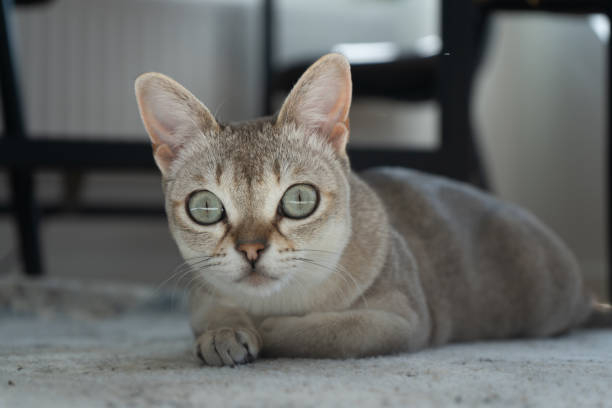
istockphoto 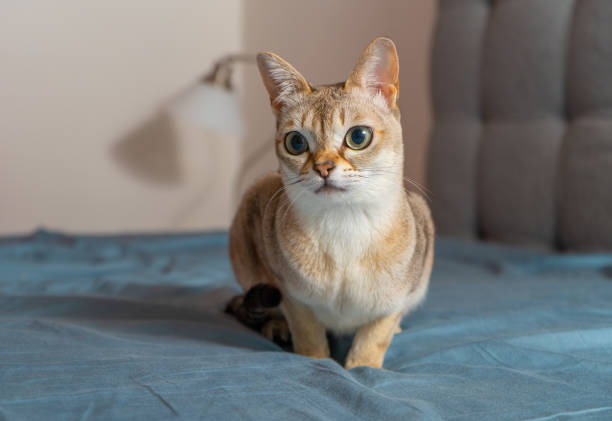
istockphoto -
The Bengal cat is a domesticated cat breed developed from a cross between the Asian leopard cat and domestic cats, particularly the spotted Egyptian Mau. The breed's name is derived from the scientific name of the leopard cat. Bengals have a wild look due to their leopard cat lineage, and their coats may feature spots, rosettes, arrowhead markings, or marbling. They are an active breed that requires a lot of exercise and play.
The Bengal cat is the only domestic cat breed with rosette markings. The Bengal is most commonly associated with its most popular color: the Brown spotted/rosetted Bengal. Despite this, Bengals come in a broad range of markings and hues. A Bengal can be red, brown, black, ticking, grey, spotted, rosetted, or cloudy, even within the Brown spotted/rosetted group. The Bengal Cat's similarity to a leopard astounds many people. Bengal markings are among the most variegated and distinctive of household cats. A "clouded bengal" is a Bengal cat with a huge rosetted coat and a great contrast in colour.
The Bengal is a spotted cat breed that ranges in size from medium to giant. Bengals are tall and thin. Because of their strong frames, Bengals are bigger than the usual house cat. Breeders have recently began selective breeding to produce Bengal cats that are similar in size to the original Asian leopard cat. Cashmere Bengal cats varies in size from medium to enormous, with males often being bigger than females.
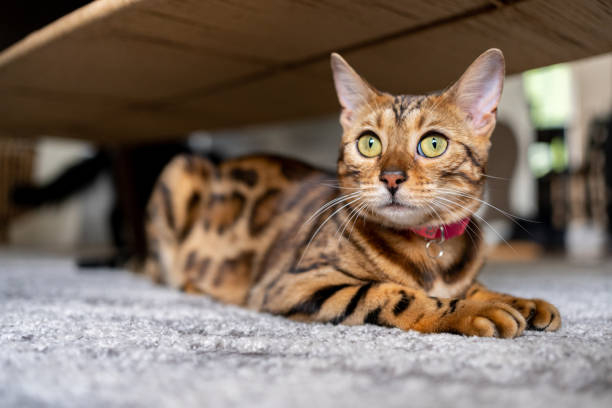
istockphoto 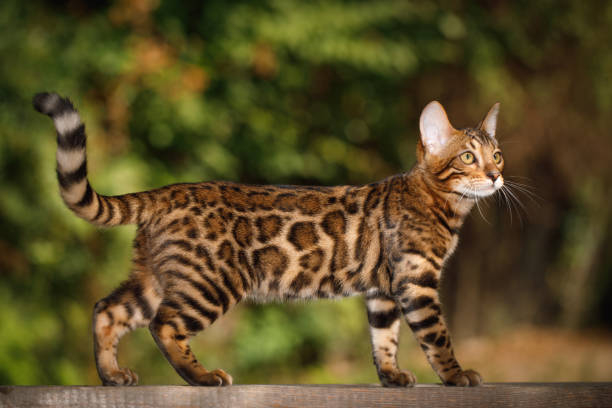
istockphoto -
The Burmese cat is a domestic cat breed that originated in Burma, is said to have its roots along the Thai-Burmese border and was developed in the United States and Britain. Most current Burmese are descended from Wong Mau, a female cat transported from Burma to America in 1930 and mated with American Siamese. From there, American and British breeders created radically separate Burmese breed standards, which is rare in the world of pedigreed domestic cats. The two are not technically recognized as different breeds by most current cat registries, but those that do refer to the British variant as the European Burmese.
The biggest difference between the two standards is the form of the head and body. The conventional or British ideal is a more slender, long-bodied cat with a wedge-shaped head, broad pointed ears, a long tapering nose, and relatively almond-shaped eyes. The legs should be lengthy as well, with tidy oval paws. The tail is medium in length. The American (also known as "current") Burmese is a stockier cat with a significantly bigger head, round eyes, and a visibly shorter, flattened nose; the ears are wider at the base. Legs and tail should be medium-length and proportional to the torso, with rounded paws.
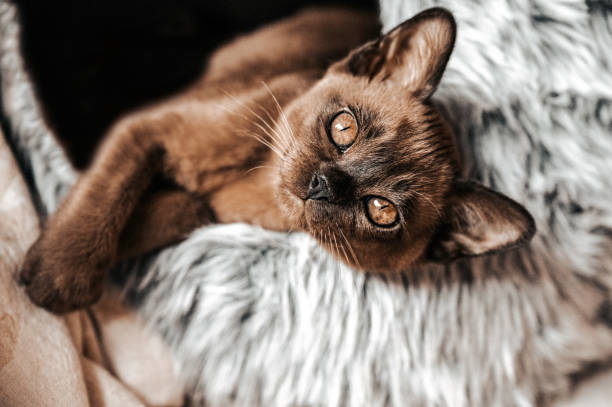
istockphoto 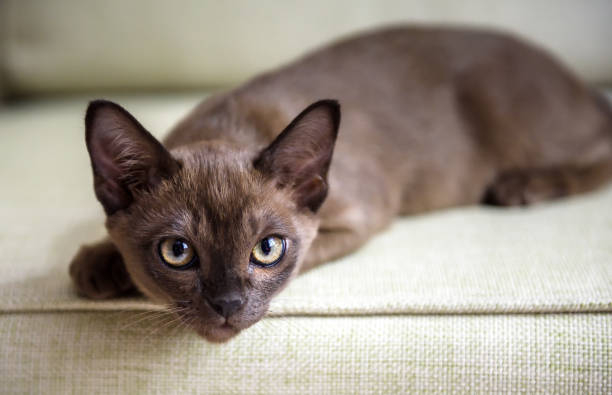
istockphoto


















